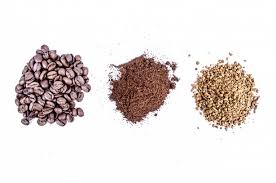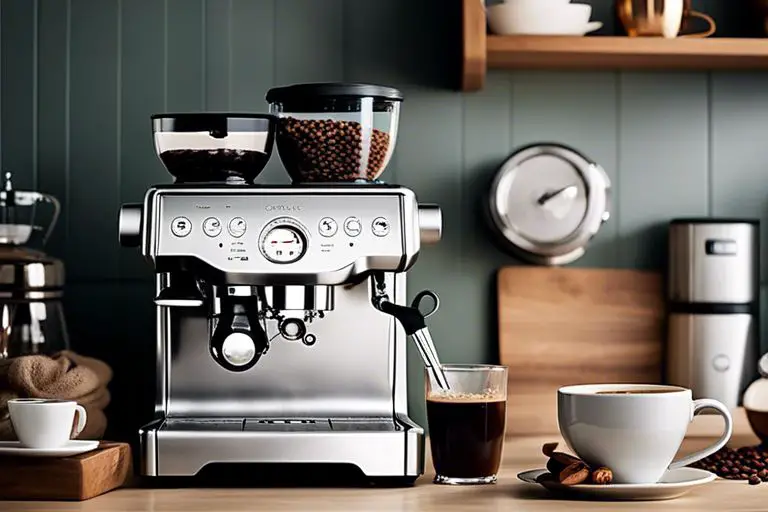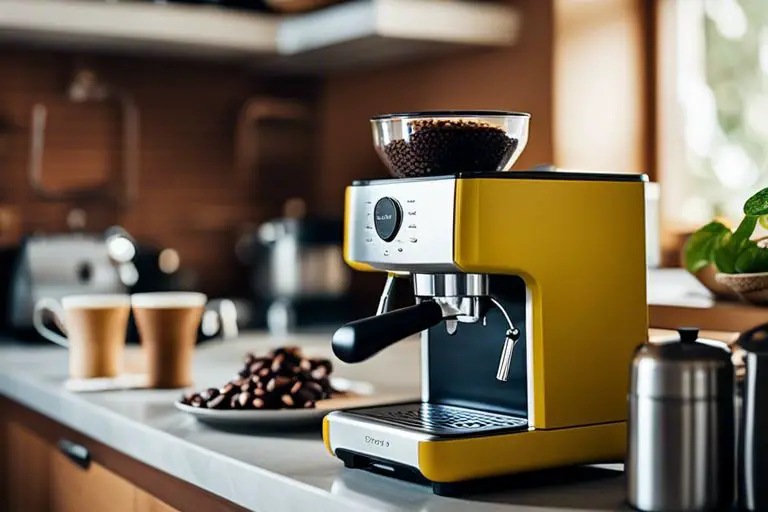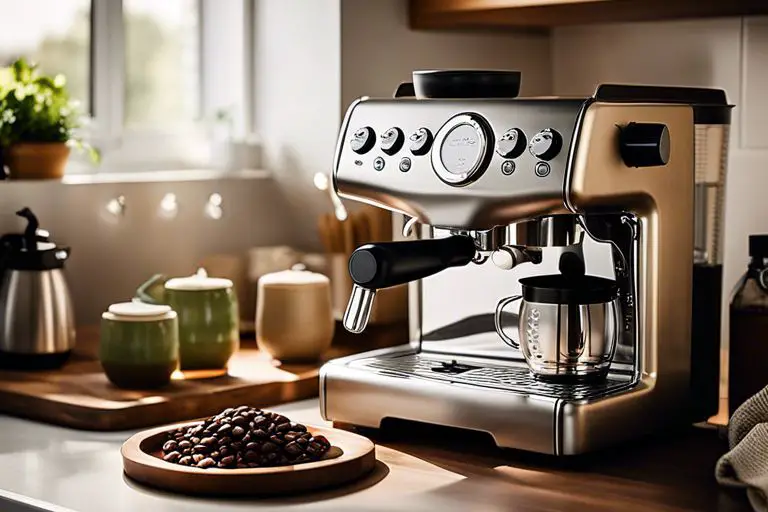Grinding coffee beans at home is the best way to achieve the best possible flavour from your coffee. Knowing how to grind coffee beans correctly is the difference between great or bad tasting coffee. Adjusting how fine the beans are ground according to the brewing method you use is crucial.
We will explain how to grind coffee beans at home in literally just a few seconds and very importantly how to grind coffee beans according to the type of coffee maker you are using.
It’s crucial to adjust how coarse or how fine the beans are ground as any slight variance has a dramatic impact on the flavour.
Don’t buy pre-ground coffee
Before we get into the different ways to grind your own beans it is worth pointing out why you should avoid pre-ground coffee even though it is much more popular than whole coffee beans in the UK.
The main reason for this is that you kind of look at whole coffee beans and think “How on earth am I going to turn those into a cup of coffee?”
We know that pre-ground coffee is much more popular because when you look at the supermarket shelves there is much more space given to pre-ground compared to whole beans. Check it out the next time you are in Tesco or Sainsbury’s or Asda or Morrisons. You’ll see the pre-ground straight away but you will have to look carefully to find the whole beans.
The supermarkets take billions of pounds each year on coffee sales so a lot of science goes into determining exactly how much space goes to each different type of product and pre-ground coffee is one type and whole coffee beans is another type.
Buying pre-ground coffee is definitely better than instant but there are a couple of really good reasons that you should buy whole beans and grind them yourself:
1. The coffee will be ground differently depending on which make or brand that you buy. This is bad because you have no control, you have to take what you get. The more control you have over your coffee the better it will taste. You could easily be using pre-ground coffee that has been ground for a cafetière and you are using it in an espresso machine or a filter coffee machine and without realising it you are getting a really bad watery coffee with hardly any flavour.
On the flip side if you are using pre-ground coffee intended for espresso in a filter coffee machine then the water will struggle to get through the coffee and into the jug making it very strong and not the flavour you are after.
2. The flavour of the coffee is locked into the bean. The minute the bean is ground you start to lose the flavour. Pre-ground coffee in the supermarket can easily have a use-by date on it of more than 1 year.
Who wants to drink coffee that has been ground a year ago? Even if it has been vacuum packed a tremendous amount of flavour will be lost during that time. You also have no idea when the beans were ground. You just get the best before date, not the grind date.
How to grind coffee beans at home
You have three different options to grind coffee beans at home. Two of them we would recommend and one we most certainly would not.
You can use an electric coffee grinder of which there are two different types. Either a blade coffee grinder or a burr coffee grinder.
Both have their place in the world of coffee bean grinding and depending on your requirements and budget using either of these methods will enable you to produce a coffee that is on a par with something you would normally be paying £3 a cup for in a coffee shop.
The other method we would strongly recommend against and that is grinding coffee beans without a grinder. If you go down that route you could damage your home or yourself or both!
If you really did want to give it a go without a grinder then you could:
1. Use a blender. Only attempt this if you already have a blender. Even the cheapest blade coffee grinder will do a much better job than a blender that is not really cut out for chopping up coffee beans. It will do it but not very well and you will have a problem getting all of the ground coffee out and then cleaning it afterwards is going to be a pain as well. This is the best of the bad ideas if you really don’t want to buy your own grinder
2. A hammer. If you wrap up some beans in a towel and give them multiple bashes with a hammer then you will definitely do some damage to the coffee beans and break them up into smaller pieces but you are unlikely to get the consistency you need to make a decent cup of coffee and you may well damage yourself in the process if you are not careful – not recommended!
3. Rolling pin. Marginally better than using a hammer because once you have beaten the beans to death you can then put pressure on the rolling pin and go over them a few dozen times to try and break the beans down a bit more. It’s going to take you about five minutes for the whole process and the end result will be rubbish. Don’t bother.
4. Pestle & Mortar. You probably already know how tough it is to bash up some spices in what is effectively a bowl with a stick. If you want a workout every time you want to make a double espresso then you can give this a go. This works ok if you want to go at it for 10 minutes every time you want to make a coffee.
All of those things are a really bad idea so let’s move on……….
How to grind coffee beans with a coffee grinder
You can pay a very small price to get a very big difference in the flavour of your coffee by using a product that has been specifically made to grind coffee beans. You got it. It’s a coffee grinder.
Incredibly, if you really want to, it is possible to pay more than £1000 for a coffee grinder. Yes really. But unless you have money to burn we would recommend you buy a holiday instead.
The good news is that you can also buy a coffee grinder for £10 that will produce nicely chopped up beans that will brew perfectly well in a cafetière or a filter coffee machine.
How many different types of coffee grinder are there?
Manual coffee grinders. These work a bit like a pepper mill where you add the beans, screw the top on and turn a handle. You can buy really cheap ones for occasional use or for travelling but you can also get really high-quality versions for the coffee connoisseur.
These types of grinders are useful if you are drinking maybe one or two cups of coffee a day and you don’t mind spending a few minutes turning the handle to produce the ground coffee. There is also some satisfaction to be had from doing it yourself and it can add to the overall coffee drinking experience.
Manual coffee grinders are also a lot more portable than their electrical counterparts. Thee is nothing to plug into the wall and they will fit neatly into any suitcase so you can bring them on your travels and enjoy a good cup of coffee wherever you are whether it be at work or on holiday.
Blade coffee grinders. If you are just getting started with grinding your own beans and you are not sure if it’s the way to go then you can minimise the risk by going ultra-budget with the Kabalo budget blade grinder. For about a tenner you can try out grinding your own beans and find out cheaply just how good and easy it is to do it yourself.
This type of coffee grinder will not always give you the same level of consistency as more expensive burr grinders but its a lot better to use a cheap blade grinder than buying pre-ground coffee so if you are used to buying pre-ground then buy one of these before investing in something more expensive.
Burr coffee grinders. If you want to try and recreate the way they grind beans in a coffee shop then a burr grinder is the way to go. These will ensure the most consistent grind which ensures the best possible flavour.
With multiple setting on most burr grinders, you can finesse the grind to exactly how it needs to be to deliver the perfect cup of coffee and one you have set it correctly for the beans you are using it will do the same thing over and over again so you will always enjoy a great-tasting cup of coffee.
You can get away with a blade grinder if you use a cafetière or a filter coffee machine because a coarse grind is better for these methods but if you are using an espresso machine then you will be better off with a burr grinder for consistently fine grinding.
How does grind size affect coffee?
Depending on the type of coffee maker you use, the size of the ground coffee particles need to be altered in order to extract the coffee flavour in the correct way.
The amount of time that water is in contact with the coffee will determine the characteristics of the coffee in your cup and different types of coffee machine mix the water with the coffee for differing periods of time.
Let’s take a look at some of the most popular methods for brewing coffee and how to grind your coffee accordingly to get the best result.
How to grind coffee beans for a cafetière
This is the cheapest way to experience freshly ground coffee. Grab yourself a cheap cafetiere and grind your beans coarsely. When we say coarse we mean a bit like soil in your hands, Nice and chopped up but with noticeable small pieces of bean still visible to the eye.
With a cafetière you need to let the coffee brew for around 4 minutes so a coarser grind really allows the water to mix with and extract the oils in the coffee.
Here is a detailed breakdown of how to make coffee in a cafetière.
How to grind coffee beans for a filter coffee machine
A filter coffee machine uses gravity to move the water through the coffee grounds and into the coffee jug. This is the most underrated way to get a good cup of coffee cheaply. Filter coffee machines are often perceived as something you use of you want to brew a big jug of coffee for loads of people but with most of them you can brew 1 or 2 mugs at a time if you want and up to 10 or 12 if you need to so you get the best of both worlds.
They are cheap too so are a great way to get started if you are trying out making fresh coffee yourself for the first time.
If the grind is too coarse then the water will just pass straight through and the coffee will be tasteless, too finely ground and the water will not be able to get through and you’ll be waiting all day for your coffee that will be so strong you won’t be able to drink it.
For a filter coffee machine you need a medium grind that is not as coarse as cafetière ground coffee beans but not as fine as the pre-ground stuff you get in the supermarkets. The consistency needs to be more like grains of sand.
How to grind coffee beans for espresso
Espresso requires a short sharp burst of water to quickly pass through the coffee for the intense espresso “hit”.
This requires a very fine grind that it makes it hard for the water to pass through the coffee at high pressure. The consistency of ground coffee for an espresso needs to be powdery with no visible signs of broken down beans.
Ideally, you want to deliver a double espresso into your cup in 25-30 seconds and this can be achieved by adjusting your grind size accordingly. If it’s too fine then it will take longer and too coarse then the water will come through too quickly. A few small tweaks is often all it needs to get it just right.
Is grinding your own coffee better?
It is much better to grind your own beans because using the guidelines above you can play around with the grind size until you get it just right and when you do the entire way you think about coffee will change for the better.
Instead of something that you just chug down to get a caffeine hit in the morning, it becomes an experience to savour and enjoy.
Using the right amount of coffee is as important as using the right grind so that you can extract the soluble coffee from the beans you have just ground. This article explains in more detail:
When should you grind coffee beans?
Always grind your beans just before you brew in order to retain the maximum freshness. As soon as the ground beans are exposed to the air the quality will start to deteriorate.
You also know that you are using decent coffee beans when you know the date they were roasted. It doesn’t guarantee a good bean but you know that the manufacturer cares more when they tell you the roasting date on the packaging, not just the best before date.
Grinding your own coffee beans and fine-tuning it until you have it just right can be done for a lot less than you think and will change your view about what is possible with coffee forever.
Here is a short video showing the different grind types and which one applies to each different brewing method:




